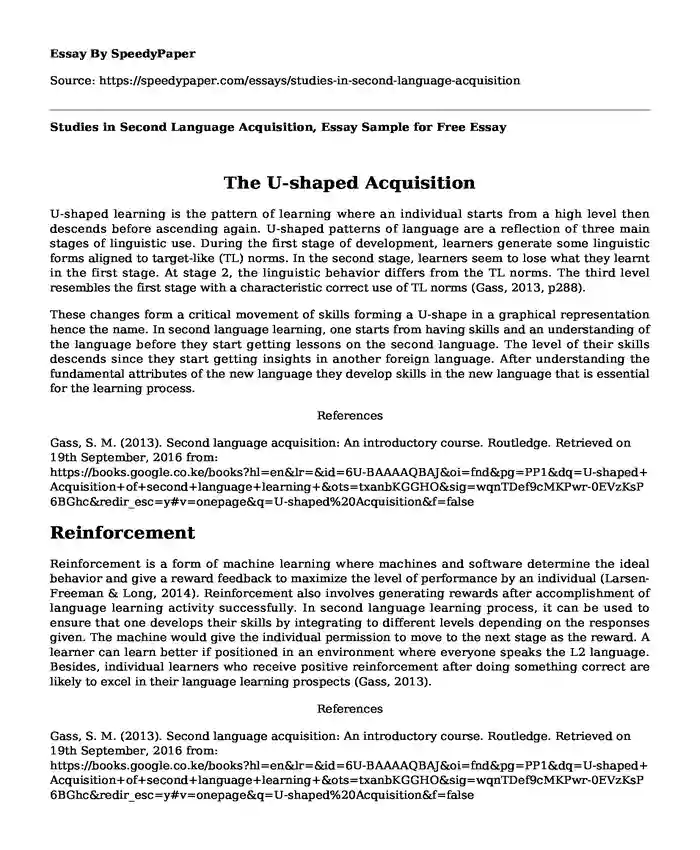The U-shaped Acquisition
U-shaped learning is the pattern of learning where an individual starts from a high level then descends before ascending again. U-shaped patterns of language are a reflection of three main stages of linguistic use. During the first stage of development, learners generate some linguistic forms aligned to target-like (TL) norms. In the second stage, learners seem to lose what they learnt in the first stage. At stage 2, the linguistic behavior differs from the TL norms. The third level resembles the first stage with a characteristic correct use of TL norms (Gass, 2013, p288).
These changes form a critical movement of skills forming a U-shape in a graphical representation hence the name. In second language learning, one starts from having skills and an understanding of the language before they start getting lessons on the second language. The level of their skills descends since they start getting insights in another foreign language. After understanding the fundamental attributes of the new language they develop skills in the new language that is essential for the learning process.
References
Gass, S. M. (2013). Second language acquisition: An introductory course. Routledge. Retrieved on 19th September, 2016 from: https://books.google.co.ke/books?hl=en&lr=&id=6U-BAAAAQBAJ&oi=fnd&pg=PP1&dq=U-shaped+Acquisition+of+second+language+learning+&ots=txanbKGGHO&sig=wqnTDef9cMKPwr-0EVzKsP6BGhc&redir_esc=y#v=onepage&q=U-shaped%20Acquisition&f=false
Reinforcement
Reinforcement is a form of machine learning where machines and software determine the ideal behavior and give a reward feedback to maximize the level of performance by an individual (Larsen-Freeman & Long, 2014). Reinforcement also involves generating rewards after accomplishment of language learning activity successfully. In second language learning process, it can be used to ensure that one develops their skills by integrating to different levels depending on the responses given. The machine would give the individual permission to move to the next stage as the reward. A learner can learn better if positioned in an environment where everyone speaks the L2 language. Besides, individual learners who receive positive reinforcement after doing something correct are likely to excel in their language learning prospects (Gass, 2013).
References
Gass, S. M. (2013). Second language acquisition: An introductory course. Routledge. Retrieved on 19th September, 2016 from: https://books.google.co.ke/books?hl=en&lr=&id=6U-BAAAAQBAJ&oi=fnd&pg=PP1&dq=U-shaped+Acquisition+of+second+language+learning+&ots=txanbKGGHO&sig=wqnTDef9cMKPwr-0EVzKsP6BGhc&redir_esc=y#v=onepage&q=U-shaped%20Acquisition&f=false
Larsen-Freeman, D., & Long, M. H. (2014). An introduction to second language acquisition research. Routledge. Retrieved on 19th September, 2016 from: https://books.google.co.ke/books?hl=en&lr=&id=4jKgBAAAQBAJ&oi=fnd&pg=PP1&dq=definition+of+%27reinforcement%27+in+language+acquisition&ots=kHQJbyZ33m&sig=7lqvVw-TkbEJAqr53pStO2LWC4M&redir_esc=y#v=onepage&q=linguistic%20competence&f=false
Critical Period
This is defined as the stage in a person’s lifespan when they should acquire a specific skill since when the window passes they may not effectively acquire the skill set that is required (DeKeyser, 2000). It is mainly used in developmental psychology since once an individual misses a specific developmental stage they may lack the ability to develop these traits in future. In second language learning, it is used in giving an indication of words or basics that should be learnt before moving to the next stage since failure may mean an individual may not the skills in future.
References
DeKeyser, R. M. (2000). The robustness of critical period effects in second language acquisition. Studies in second language acquisition, 22(04), 499-533. Retrieved on 19th September, 2016 from: https://www.cambridge.org/core/services/aop-cambridge-core/content/view/6963A1AFEB8148B7F3B719D60994CD65/S0272263100004022a.pdf/the-robustness-of-critical-period-effects-in-second-language-acquisition.pdf
Stabilization
As the word suggests it is the process of cementing or creating a background and basis for developing specific skills (Gass, 2013). Stabilization entails augmenting the individual traits required through developing and giving basic skills to an individual. Stabilization ensures that one gains insights and develops their skill set further. It is essential in second language learning since it gives an individual the basis to develop their skills and learn different aspects of language.
Reference
Gass, S. M. (2013). Second language acquisition: An introductory course. Routledge. Retrieved on 19th September, 2016 from: https://books.google.co.ke/books?hl=en&lr=&id=6U-BAAAAQBAJ&oi=fnd&pg=PP1&dq=U-shaped+Acquisition+of+second+language+learning+&ots=txanbKGGHO&sig=wqnTDef9cMKPwr-0EVzKsP6BGhc&redir_esc=y#v=onepage&q=U-shaped%20Acquisition&f=false
Linguistic Competence
Linguistic competence Refers to the linguistic knowledge that is possessed by a native speaker of a language (Gass, 2013). An individual who has been well versed with a specific language has traits that enable them to be conversant and have the underlying ability needed to be good in the language. Native speakers have the characteristics and traits that are required to master the linguistic forms and aspects of a language. Linguistic competence as the main concerns of modern linguistics create emphasis on what speakers know compared to what they do on certain occasions. The first factor to consider regarding linguistic competence is the reduction of differences in the ability between different SL learners (Gass, 2013).
Reference
Gass, S. M. (2013). Second language acquisition: An introductory course. Routledge. Retrieved on 19th September, 2016 from: https://books.google.co.ke/books?hl=en&lr=&id=6U-BAAAAQBAJ&oi=fnd&pg=PP1&dq=U-shaped+Acquisition+of+second+language+learning+&ots=txanbKGGHO&sig=wqnTDef9cMKPwr-0EVzKsP6BGhc&redir_esc=y#v=onepage&q=U-shaped%20Acquisition&f=false
Cite this page
Studies in Second Language Acquisition, Essay Sample for Free. (2017, Oct 12). Retrieved from https://speedypaper.net/essays/studies-in-second-language-acquisition
Request Removal
If you are the original author of this essay and no longer wish to have it published on the SpeedyPaper website, please click below to request its removal:
- Free Essay on Racial and Ethnic Biases in the Film The Scottsboro Boys: An American Tragedy
- Atomic Bombs and Other Inventions Used in War, Essay Sample
- Trauma and Addiction Essay Sample
- Free Essay. Economics-Walmart and the Wage Debate
- Essay Sample on the Flat Earth Theory
- Essay Sample on Comparing Nationalism in the Philippines and Burma
- Essay Example: Nursing Diagnosis for Hypovolemic Shock
Popular categories





